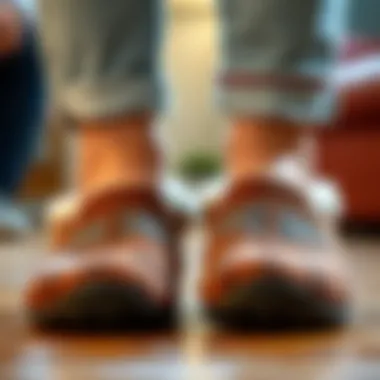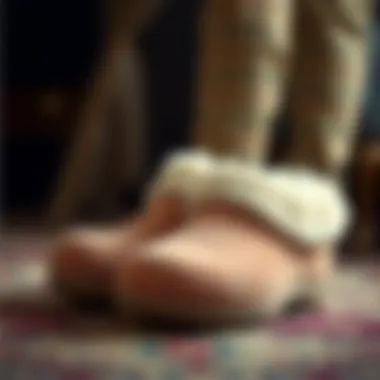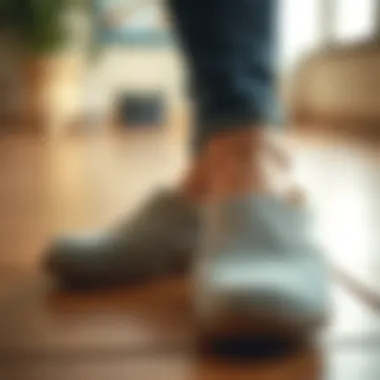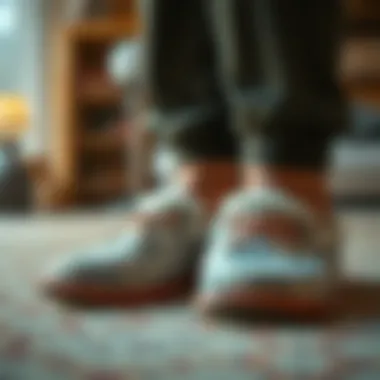Essential Safety Slippers for Seniors: A Complete Guide


Intro
Safety slippers are no longer just an afterthought; they are essential footwear for the elderly, contributing to their daily comfort and mobility. As people grow older, the risk of slips and falls increases significantly. Therefore, paying attention to footwear choices is vital for both safety and quality of life.
Understanding the importance of these slippers involves considering various factors, including how slip resistance, comfort, and proper fit come into play. This becomes even more crucial as older adults navigate spaces that may be less forgiving, such as slick floors or uneven surfaces.
In this guide, we will explore the features that make safety slippers an ideal choice for seniors. We will discuss the benefits of innovative designs that offer support without sacrificing style, ensuring that comfort does not lead to compromising aesthetic appeal.
Furthermore, we will review crucial lifestyle considerations as well as buying tips geared towards caregivers and family members. These insights can empower individuals to make well-informed decisions, ultimately enhancing not only physical well-being but also the overall confidence and independence of older adults.
In this context, let’s delve deeper into one of the fundamental elements of safety slippers—the materials used in their construction.
Fabric Knowledge
Types of Fabrics
When looking at safety slippers, the fabric plays a pivotal role in determining comfort and safety. Here’s a look at some common materials:
- Fleece: Soft, warm, and generally non-slip, fleece can provide extra comfort in chilly climates.
- Cotton: This breathable material is light, making it suitable for all-day wear, especially in warmer temperatures. Look for cotton blends that offer a little stretch.
- Synthetic Materials: Often used for their durability and ease of care, synthetic options can provide specific features, like moisture-wicking and quick-drying properties.
- Leather: Although less common, some slippers utilize leather for a more sophisticated look. They can offer better structure and support but should be treated properly to maintain their quality.
How to Care for Different Fabrics
Maintaining the slippers is critical for ensuring their longevity:
- Fleece: Wash them on a gentle cycle and avoid fabric softeners, as they may reduce the fabric's texture and warmth.
- Cotton: These are easy to care for; machine wash and tumble dry with like colors.
- Synthetic Materials: Follow the manufacturer's instructions; often, gentle washing and air-drying can prolong the slipper’s life.
- Leather: Regularly clean them with a damp cloth and use a conditioner to keep the leather supple.
"The right fabric in safety slippers can be the difference between comfortable mobility and damaging falls."
As we progress through this guide, remember that when selecting safety slippers for the elderly, understanding the fabrics and how to care for them can greatly enhance their durability and utility.
Next, we should explore more about features, styles, and specific benefits that safety slippers can offer to older adults.
Intro to Safety Slippers
When it comes to the topic of safety slippers, the significance cannot be overstated, especially for the elderly. This guide dives into a realm where comfort meets security, offering insights tailored specifically for the demographic most at risk of slips and falls. For older adults, mobility can sometimes feel like walking a tightrope. Every step counts and the right footwear can make all the difference.
Understanding the needs of this audience is crucial. Safety slippers come equipped with features that address the unique challenges faced by seniors. They are not just any footwear; they are a lifeline that provides stability and comfort. By minimizing the risk of falls, these slippers serve as a preventative measure that contributes to the overall well-being of older adults.
Furthermore, selecting the right safety slippers involves considering several factors such as slip-resistance, cushioning, and breathability. Each element plays a vital role in enhancing not just safety, but also the quality of life for the elderly, who face multiple challenges as they age.
In the subsequent sections, we will dissect the core features of safety slippers, explore various types available in the market, and delve into how these slippers can serve as a critical component in fall prevention strategies.
Understanding the Need for Specialized Footwear
The elderly population is particularly vulnerable to foot-related issues. As one ages, the body undergoes several changes, including weakened muscles, reduced bone density, and diminished proprioception. This makes it increasingly important for seniors to wear specialized footwear designed to support their unique needs. Ordinary slippers often fall short of providing the necessary features required for safe ambulation. Safety slippers are specifically crafted to address these challenges, providing support at an age when every misstep is magnified.
Some common concerns include:
- Weak arches and flat feet: Many older adults experience foot conditions that alter their natural gait. Safety slippers with arch support can significantly improve posture and relieve discomfort.
- Poor balance and coordination: Slippers that offer a non-slip sole can mitigate the risks posed by sudden slips when walking on smooth surfaces.
- Swelling and foot pain: Adjustable designs allow individuals to customize fit, accommodating foot changes that are often associated with age.
Notably, safety slippers also play a psychological role by fostering confidence among seniors. Knowing that they are wearing appropriate footwear can empower them to be more active in their daily lives.
Impact of Footwear on Mobility
Footwear has a remarkable impact on mobility among older adults, often serving as the foundation for physical activity. Ill-fitting or inappropriate footwear can lead to a range of issues, including decreased movement, which can spiral into a more sedentary lifestyle. The implications of this are profound, as reduced mobility can lead to a host of additional health concerns, such as obesity, muscle atrophy, and even mental health issues like depression.
By wearing well-designed safety slippers, elderly individuals can:
- Enhance their range of motion: A good pair of slippers allows for easier movement, enabling seniors to navigate their homes and outdoor spaces more confidently.
- Reduce fatigue: Proper cushioning and support can minimize strain on the feet, allowing seniors to stay active for longer periods without feeling fatigued.
- Boost social interactions: Increased mobility encourages seniors to engage more with community activities, family outings, and even social clubs, contributing positively to their mental health.
In essence, the right footwear, like safety slippers, doesn't just protect the feet; it plays a pivotal role in maintaining the overall quality of life for older adults. The following sections will further elaborate on the essential features of safety slippers, helping caregivers make informed decisions.
Core Features of Safety Slippers


When it comes to safety slippers for the elderly, certain core features can significantly impact their functionality and comfort. Understanding these features is key for caregivers and family members who want to ensure the safety and well-being of their loved ones. Each element plays a unique role in providing the right balance of safety, support, and comfort, making it crucial to highlight them.
Slip-Resistant Soles
Slip-resistant soles are the cornerstone of any reliable safety slipper. Elderly individuals often face a higher risk of falls, and a slipper that lacks proper traction can make everyday movements dangerous. These soles are designed with specific materials and tread patterns that grip surfaces, thus reducing the likelihood of slipping.
"Proper grip is like having a safety net on the floor; it gives you a sense of security, especially when you're on your feet."
When shopping for safety slippers, look for soles that are made from rubber or similar non-slip materials. Consider slippers with patterns—like deep grooves or herringbone designs—as they often enhance grip. An important consideration is the slipper’s weight; lighter slippers allow for easier movement without compromising stability.
Cushioning and Support
A well-cushioned slipper not only enhances daily comfort but also plays a significant role in maintaining foot health. Aging feet may suffer from various ailments, such as arthritis or plantar fasciitis. Slippers with adequate cushioning can absorb impact and relieve pressure, making activities more pleasant.
Support comes in multiple forms: arches, heels, and even heel counters can stabilize the foot and prevent unnecessary strain. Look for slippers that have thicker soles with contoured designs, as they can provide better support over time.
Keep in mind that not every type of cushioning is suitable for everyone—a softer sole might feel great to one person but inadequate to another. Therefore, it's critical to assess how one feels while walking in them.
Breathable Materials
Breathability is an essential feature that often goes unnoticed. Feet can sweat, especially when wearing shoes for long periods, and this moisture can lead to various foot problems. Slippers constructed from breathable materials, such as cotton or special mesh fabrics, allow air circulation, helping to keep feet dry and comfortable.
Moreover, breathable slippers can reduce the risk of developing fungal infections, something particularly relevant for the elderly. In humid climates or during warmer months, choosing slippers with moisture-wicking properties is a smart choice. They not only provide comfort but also promote better foot hygiene—an often overlooked yet significant concern.
Adjustable Fit
The ability to adjust the fit is another core feature that enhances both safety and comfort. Many elderly individuals may experience swelling or changes in foot size, making it essential for slippers to accommodate these changes. Options like Velcro straps or elastic bands are preferable, as they allow for a customized fit.
An adjustable fit can prevent slippers from slipping off or becoming too tight, both of which can lead to discomfort or falls. Caregivers should take the time to ensure that slippers fit snugly without being constrictive; this balance is critical for maintaining mobility and security.
In summary, the core features of safety slippers—a focus on slip-resistant soles, proper cushioning and support, breathable materials, and adjustable fit—collectively contribute to a safer and more comfortable experience for elderly users. Selecting slippers that prioritize these aspects will not only enhance comfort but could also play a pivotal role in fall prevention.
Types of Safety Slippers
In the realm of safety slippers, understanding the different types available is crucial. Each design caters not only to functionality but also to personal preference and specific needs. For the elderly, the choice of safety slippers is not just about style—it's about ensuring comfort, support, and, most importantly, safety.
Closed-Toe vs. Open-Toe Designs
When choosing safety slippers, a primary decision is between closed-toe and open-toe designs. Closed-toe slippers offer more warmth and protection. They wrap around the foot securely, which can help prevent accidental slips. This design is particularly beneficial in cooler weather or when safeguarding against potential injuries from stubbing toes.
On the other hand, open-toe slippers provide ventilation which can be more comfortable during warmer months. They allow the feet to breathe, helping to prevent moisture buildup, which can lead to odor or fungal issues. However, it's vital to remember that open-toe slippers might leave the toes exposed, potentially increasing the risk of injuries.
"The choice between closed-toe and open-toe can really affect not just comfort but footing stability—particularly for those who are at risk of falling."
So, the decision often comes down to individual comfort preferences and seasonal needs. A quick scan of a user’s lifestyle and foot needs can clarify which design reigns supreme.
Indoor vs. Outdoor Options
Another significant factor is whether the slippers are intended for indoor or outdoor use. Indoor slippers are usually designed with softer soles that provide comfort on surfaces like tile or carpet. These slippers prioritize warmth and support for home activities, where the risk of slipping mainly occurs on smooth floors.
Conversely, outdoor slippers often feature sturdier, slip-resistant soles that can handle various terrains. They might also include waterproof materials for those quick trips outside, ensuring the wearer's feet remain dry and comfortable.
Having the right pair for each environment is like having the best tool for the job; it makes a world of difference. A mixed approach can be beneficial too—using indoor slippers for home while having outdoor ones handy for necessary excursions.
Medical-grade vs. Regular Options
Lastly, there's a distinction between medical-grade and regular safety slippers. Medical-grade options are specifically designed with the unique needs of older adults in mind. They often incorporate orthopedic features like arch support and stable bases, which accommodate particular medical conditions such as diabetes or arthritis. These slippers may be prescribed by health professionals to ensure maximum safety and comfort, thus reducing the risks associated with foot-related issues.
In contrast, regular safety slippers can still provide comfort and protection but may lack the specialized features that cater to specific medical needs. They usually focus on general safety and comfort without the rigorous design required for certain health concerns.
The Role of Safety Slippers in Fall Prevention
Ensuring the safety of elderly individuals is paramount, especially when it comes to minimizing the risk of falls. Safety slippers are more than just comfortable footwear; they play a significant role in fall prevention. With aging, the risk of falls increases due to various factors such as decreased balance, weakened muscles, and reduced vision. Footwear can either mitigate or exacerbate these risks. Utilizing appropriate safety slippers not only enhances comfort but also increases stability, providing a layer of protection that is crucial for older adults navigating their daily routines.


Statistics on Elderly Falls
The statistics regarding falls among elderly people are quite alarming. It’s reported that one in four older adults fall each year in the United States. This stat translates into millions suffering from serious injuries like fractures, head injuries, and even fatal accidents. Notably, falls are the leading cause of injury-related deaths in older individuals, with hip fractures often resulting from a fall causing long-term mobility issues, or even greater health complications.
"The odds of an elderly person falling increase significantly with each passing year, emphasizing the critical need for preventive measures like safety slippers."
Beyond just physical injuries, falls have severe emotional consequences as well, instilling fear and leading to a decrease in social activity. Research also suggests that over 50% of fall victims develop a fear that may prompt them to limit their movements, and thus further contribute to a decline in their overall health. It’s clear that understanding these statistics points to the pressing need for effective strategies to reduce fall risks, with proper footwear being a fundamental aspect.
How Proper Footwear Reduces Risks
Investing in the right safety slippers can significantly diminish the chance of falls. Here’s how:
- Grip and Traction: Safety slippers often feature slip-resistant soles that enhance traction. Unlike typical slippers, these soles reduce the likelihood of accidental slips on various surfaces—be it in the kitchen or bathroom.
- Cushioning for Balance: Quality safety slippers provide adequate cushioning, helping to absorb shock. This is crucial for older adults as it aids in maintaining balance while walking, reducing the chances of a fall due to a misstep.
- Supportive Fit: Many safety slippers are designed with adjustable features or a snug fit that accommodates the foot’s natural shape. This support helps prevent the foot from sliding within the slipper, which might otherwise lead to an accidental trip or fall.
- Increased Awareness: The choice of vibrant or distinctive colors can help make the slippers more noticeable, serving as a visual cue that enhances awareness of one's foot placements, ultimately preventing missteps.
Overall, selecting proper footwear designed specifically for safety can be a game changer. It not only gives older adults a sense of security but also fosters their independence by encouraging mobility. Making informed choices about safety slippers becomes an essential part of crafting an environment where falls are a rarity rather than a norm.
Considerations for Caregivers
When it comes to ensuring the safety and comfort of elderly individuals, caregivers serve as crucial decision-makers. This section centers on the essential considerations for caregivers when selecting safety slippers for older adults. Choosing appropriate footwear is more than just a matter of style; it significantly impacts mobility, independence, and overall well-being.
Assessing Individual Foot Needs
Each elderly person has unique foot needs influenced by various factors such as health conditions, foot shape, and mobility. Caregivers need to conduct a thorough assessment to determine what type of footwear will best serve each individual.
- Foot Health: Conditions like diabetes, arthritis, or neuropathy can affect foot requirements. For instance, while someone with arthritis might benefit from shoes with cushioned arches, a diabetic may need slippers with seamless interiors to prevent skin irritation.
- Foot Size and Shape: Not all brands cater to the same foot sizes or shapes. It’s crucial to measure the foot correctly and consider features like width and toe box shape. An incorrect size can lead to discomfort and increase the risk of falls.
- Gait and Balance Issues: Understanding the individual's walking patterns informs the choice of shoes with the correct support features. A person with unsteady gait might require shoes with a broader base for better balance.
An assessment can be done through simple observations or by consulting with a podiatrist. Consequently, selecting the right safety slipper can maintain not just comfort but also optimize mobility and safety for the elderly.
Understanding Personal Preferences
While practical considerations are essential, it's equally important to respect the personal tastes and preferences of older adults when choosing safety slippers. Their choices can significantly influence their willingness to wear the slippers regularly.
- Style and Aesthetic Appeal: Many elderly individuals have specific styles or colors they prefer. Getting them involved in the selection process allows them to feel empowered. Their choice shouldn’t compromise safety, but it can definitely align with their preferences.
- Functionality vs. Fashion: It’s vital to balance style with functionality. A beautiful slipper that lacks essential safety features won't be effective. Engaging the individual in discussions about what they find appealing can lead to discovering designs that meet both safety and aesthetic requirements.
- Ease of Use: Ease of putting on and taking off the slippers is another significant factor. For people who may struggle with mobility, opting for designs with wide openings and Velcro straps might be more favorable than those requiring bending or intricate operations.
By taking the time to listen and involve older adults in the decision-making process, caregivers can select safety slippers that they are more likely to wear. This approach fosters respect, autonomy, and comfort while ensuring that safety remains the top priority.
In moving forward, understanding the intricate details of footwear needs and personal preferences enables caregivers to foster environments where elderly individuals can thrive independently and confidently.
Popular Brands and Models
When it comes to selecting safety slippers for elderly individuals, understanding the varying brands and models is crucial. Each brand offers its own unique features, styles, and technologies that cater specifically to the needs of older adults. With the vast array of options available, it can be quite overwhelming for caregivers and family members to sift through the choices. Hence, being aware of reputable brands and their offerings not only helps in making informed decisions but also contributes to ensuring safety, comfort, and support.
Among the advantages of popular brands is their commitment to the quality and innovation seen throughout their product lines. Established names tend to invest in research and development to enhance aspects like slip resistance and cushioning, which can be pivotal in fall prevention. Often, these brands also offer warranties or satisfaction guarantees that might not be available with lesser-known options.
To further guide your selection, it's helpful to explore comparisons between these brands. Each brand emerges with distinct characteristics, warranties, and price points that could significantly impact your choice. Here, we highlight some considerations while comparing brands:
- Quality of Materials: Durable, breathable materials may enhance comfort and longevity.
- Slip Resistance Features: Examine the tread patterns and material used for soles to assess safety.
- Fit and Adjustability: Some brands are known for their focus on an adjustable fit that can accommodate various foot sizes.
- Design and Aesthetics: While functionality is paramount, the look and feel of slippers can also influence decisions.
- Review Scores: Looking into user feedback often reveals insights into wear and longevity.
To summarize, establishing a strong understanding of popular brands and models serves not just to inform, but empowers caregivers in making choices that align with specific needs and preferences.
Brand Comparisons
In the quest for selecting the ideal safety slippers for elderly people, comparing different brands can shine a light on which options stand out and why. For instance, Acorn is known for its plush designs and use of eco-friendly materials, while Dr. Scholl's leans heavily into the comfort and medical-grade support categories.
Moreover, Skechers prides itself on offering a range of styles, catering to both indoor and outdoor use with slip-resistant soles. On the other hand, Orthofeet particularly specializes in biomechanically-engineered footwear that provides substantial arch support, reducing strain during wear.
When you look at specifics:
- Price Range: Some brands like Crocs offer more affordable options while others, such as Vionic, may come at a higher price due to their specialized supports.
- Targeted Features: Whether you're looking for orthopedic support or simple everyday comfort, brands have tailored products designed for different needs.
- Breathability: Not all slippers are created equal when it comes to ventilation. Brands like Isotoner utilize materials that promote airflow, crucial for extended wear.
Taking these elements into account can help in narrowing choices suited for individual preferences and needs.
User Reviews and Experiences
User feedback is a window into the performance of safety slippers in real-life situations. It provides a nuanced understanding of how various models fare in everyday activities, particularly for elderly folks whose feedback can reflect their satisfaction with comfort and safety features. Reading user reviews can unearth beneficial insights into design durability, ease of use, and practicality.
For instance, many users highlight the excellent grip offered by Stablewear slippers, especially on slippery surfaces, underscoring their impact in reducing fall risks. Alternatively, older adults wearing Bamboo slippers often mention their exceptional moisture-wicking properties, adding to comfort during prolonged wear.


While it’s easy to be swayed by marketing claims, real-world experiences often paint a different picture. Users will frequently share their stories when a pair of slippers have either liberated them from discomfort or, on the contrary, disappointed them.
"I never knew slippers could make such a difference. The tread on these really helps me feel secure when moving around. I just wish they came in more colors!" - An avid user review.
When considering feedback, it's important to pay attention to recurrent themes in reviews, such as comments about fit, how easily the slippers can be put on or taken off, and their ability to maintain comfort throughout the day. This insight can vastly affect the decision-making process when searching for the perfect pair.
Innovations in Safety Slippers
The landscape of safety slippers for the elderly is changing fast, and it’s not just about comfort anymore. Innovations play a key role in transforming how these slippers can enhance not only safety but also the overall quality of life for older adults. Here, we’ll dive into two main areas making waves in this space: smart technology integration and eco-friendly materials.
Smart Technology Integration
Imagine slippers that can do more than just cover your feet. With the rise of smart technology, some brands have started to incorporate features that actively monitor the wearer’s movement and health. For instance, slippers equipped with built-in sensors can track steps, detect falls, and even alert caregivers in case of an emergency. These technological advancements offer peace of mind for both the elderly and their family members, ensuring that help is just a button press away.
Moreover, some smart slippers can connect to mobile apps, giving users and caregivers a comprehensive overview of activity levels and patterns over time. This data can be crucial for determining changes in mobility and overall health, prompting timely interventions when necessary. Just picture this: a parent who enjoys independence while knowing their loved ones are just a ping away whenever support is needed.
Eco-friendly Materials
In recent years, sustainability has gained prominence in various sectors, including footwear. Eco-friendly materials are making a splash in the safety slipper market, offering a guilt-free option for environmentally-conscious consumers. By using materials that are sustainably sourced, recycled, or biodegradable, manufacturers are not only catering to an audience that cares deeply for the planet, but they're also ensuring that the slippers can be gentle on the skin of their elderly users.
Natural materials like organic cotton, bamboo, and even recycled plastics have become popular choices in creating safe, breathable slippers. Not only do they minimize environmental impact, but they also reduce the risk of allergic reactions that are common with synthetic fabrics. This approach represents a win-win scenario: the wearer enjoys comfort without compromising on their values, and the planet takes a deep breath too.
"Integrating technology and eco-conscious materials isn't just a trend, it's a commitment to healthier living for both people and the planet."
The innovations in safety slippers go beyond aesthetics; they reflect a shift toward more mindful consumer choices. As we move forward, we can expect further advancements that will make these slippers even more protective, adaptable, and suitable for the unique needs of the elderly.
Embracing these innovations means that caregivers and seniors alike can enjoy a new era of footwear that honors safety and well-being.
How to Properly Care for Safety Slippers
Proper care for safety slippers is crucial not just for longevity, but also for maintaining their essential features. When it comes to elder care, the well-being and safety of older adults take precedence. Slippers that are well-maintained can help in preventing accidents and ensure comfort. Plus, neat and fresh footwear often boosts the wearer’s confidence, which is invaluable for their mental health. Therefore, understanding the cleaning and maintenance requirements of safety slippers is integral to keeping them functional and appealing.
Cleaning and Maintenance Tips
Keeping safety slippers clean and in good shape is straightforward, yet it requires a regular routine. Here are some practical tips to help with this:
- Gentle Washing: Most safety slippers can handle a hand wash. Use mild soap with lukewarm water. Avoid hot water as it may warp the materials used.
- Spot Cleaning: For stains or spills, take a damp cloth and dab the affected area rather than scrubbing it. This prevents potential damage to the slipper’s fabric or sole.
- Air Dry: After washing, let the slippers air dry. Avoid placing them under direct sunlight or near heaters, as excessive heat can damage the structure.
- Odor Removal: Occasionally, sprinkle baking soda inside the slippers and let them sit overnight before shaking it out to eliminate odors. It’s a simple method that yields good results.
- Regular Inspection: Check for signs of wear and tear, such as loose seams or thinning soles. Address any repairs needed promptly.
Proper cleaning extends the life of safety slippers. A little effort can go along way!
By adopting a cleaning routine, not only do you enhance safety but also comfort, which plays a significant role in the overall satisfaction of the user.
When to Replace Slippers
Knowing when to toss out a pair of slippers might be less intuitive than how to clean them. Safety slippers should be replaced under circumstances that might compromise safety or comfort. Here are some indicators:
- Visible Wear: If the sole has lost its grip, or if there are noticeable holes or tears in the material, it’s time to consider a new pair. Safety slippers should maintain their slip-resistant properties.
- Compromised Support: If the cushioning feels insufficient or if there’s a change in fit (like becoming too loose), this could lead to discomfort or even cause falls.
- Persistent Odor: Sometimes, even after thorough cleaning, slippers may hold onto odors. If they start to smell, it's a good sign that it’s time for a fresh pair.
- Changes in Mobility: For older adults, mobility can change over time. If a senior’s foot is now swelling more than before, which often happens with age, a new slipper that accommodates these changes might be necessary.
In summary, regular cleaning and a keen eye for wear and tear can greatly enhance safety and comfort for elderly individuals wearing safety slippers. Taking these steps ensures that caregivers can provide not just immediate safety but also a comforting consistency, allowing seniors to feel secure as they navigate their day-to-day lives.
The End
Safety slippers are not just a niche product; they represent a significant element in maintaining the well-being of elderly individuals. This article delves into the intricate details surrounding these slippers, emphasizing their critical role in enhancing safety, comfort, and mobility. By prioritizing features such as slip resistance, cushioning, and proper fit, caregivers and family members can make wiser choices in footwear that directly impact the quality of life for older adults.
Summarizing Key Insights
In examining the core aspects of safety slippers, we found that the unique characteristics play a vital role in fall prevention. The following highlights encapsulate essential takeaways:
- Slip Resistance: The soles designed with slip-resistant materials significantly reduce the chance of accidents on various surfaces.
- Comfort and Support: High-quality cushioning provides comfort, fostering greater mobility and reducing fatigue.
- Breathability and Fit: Fabrics that allow for airflow and adjustable sizing ensure that slippers accommodate the changing foot shape of elderly users.
Moreover, different styles cater to specific needs and lifestyles. Whether it’s a closed-toe slipper for indoors or a robust option suitable for outdoor activities, the diversity in designs empowers older adults to choose based on personal preference and safety requirements.
The integration of smart technologies is a trend that supports monitoring and enhances safety, while eco-friendly materials reflect a growing awareness around sustainability. These insights not only elucidate the importance of safety slippers but also encourage a thoughtful selection process for caregivers.
Looking Ahead: Future Trends
The landscape of safety slippers for the elderly is evolving at a rapid pace, driven by innovations that prioritize health and well-being. Here are some anticipated trends:
- Integration of Technology: Look for slippers that incorporate features like motion sensors, which can alert caregivers if a fall occurs, providing peace of mind.
- Customizable Options: As personalization grows in demand, expect to see slipper designs that allow for customized features, like adjustable arch support or temperature-regulating materials.
- Sustainability in Production: The growing emphasis on eco-friendly practices is likely to influence product development, with brands increasingly focusing on sustainable materials and production methods.
As we keep our eyes on these trends, understanding how they can shape the future of safety slippers will be crucial for stakeholders in the sector, from manufacturers to caregivers. This forward-thinking approach ensures that footwear designed for the elderly continues to evolve, meeting ever-changing needs while maintaining a commitment to safety and comfort.















